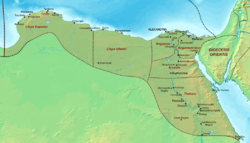
The diocese of Ammonia (Latin: Dioecesis Ammoniacensis) is a suppressed and titular see of the Roman Catholic Church. [1] It is all that remains of the ancient bishopric that was centered the Siwa Oasis during late antiquity, [2] when it was in the Roman province of Marmarica and suffraged by the archdiocese of Darni. Today Ammoniace survives as a titular bishopric and has been vacant since January 24, 1983. [3]